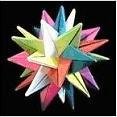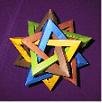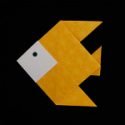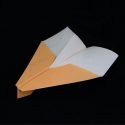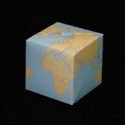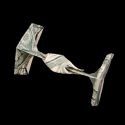Modular Origami
Modular origami, also called unit origami, requires two or more pieces of paper. The paper is folded into a shape called a “unit” or a “module”. Many units are assembled together to form the final origami model.
Often, the final model looks remarkably different compared to the appearance of the units themselves. Go to Origami Heaven for great information and to Modular Mania for great photos. [Photo: “UVWXYZ” by M. Mukerji].
The best modular origami models have the following features:
- Units are easy to fold
- Units can easily be assembled
- finished model maintains its shape without glue or tape
- finished model is pleasing to the eye.
[“FIT” by Tom Hull; photo by E Westcott]
Some units, like the Sonobe unit, are versatile. The number of units used, and the way the units are assembled can change the appearance of the final model. Charles Esseltine’s TSU can also be assembled in different ways. [Photo: “TSU” octahedron by C Esseltine]
Almost all models of this type are
polyhedrons, though Nick Robinson has a modular caterpillar and there are many flat models such as
stars, wreaths and rings. [Photo: “Traditional Spikey Star”]
Some unit origami diagrams start with A-shape paper. This is the
International Standard sized paper that is used all over the world except in USA and Canada. The unique feature of this rectangular sheet is that the height:width ratio is √2:1. Because of this ratio, a sheet of A4 paper (8.25″ × 11.7″) can be cut in half to give two sheets of A5 which also have a height:width ratio of √2:1. This shape is sometimes called a
silver rectangle. You can
make A-sized paper from USA letter-sized sheets, or you can
buy A4 paper
Whether you are using a A-shape or square piece of paper, it is important that the sheets are EXACT in size. Sheets that are not exact will cause the units to be difficult to assemble. You may wish to get a good
paper cutter.
-
Books with Modular Origami
- Marvelous Modular Origami by Mukerji
- Polyhedron Origami for Beginners (Origami Classroom) by M Kawamura
- Origami Wreaths and Rings by David Petty
- Unit Origami: Multidimensional Transformations by Tomoko Fuse
- Unit Polyhedron Origami by Tomoko Fuse
- Beginner’s Book of Modular Origami Polyhedra: The Platonic Solids by Rona Gurkewitz and Bennett Arnstein
- 3-D Geometric Origami by Rona Gurkewitz and Bennett
- Modular Origami Polyhedra (Origami) by Lewis Simon, Bennett Arnstein, and Rona Gurkewitz
- Multimodular Origami Polyhedra: Archimedeans, Buckyballs and Duality by Rona Gurkewitz and Bennett Arnstein
- Unfolding Mathematics with Unit Origami by Betsy Franco
Buy Books with Modular Origami
Please Help
|
Please help by reporting broken links so that we can fix them. One easy message from you can save us hours and hours of clicking. Thanks!
|
-
More Origami Diagrams and Instructions…
-
These free origami instructions are made available to you by the paper folding community at large. If you have a diagram you would like to share, or if your diagram is listed here and you wish to have it removed, please Contact Us. Diagrams are intended for personal use. Copyright of the models lie with the origami creators and designers. Please contact the designer and/or creator directly for non-private usage of a model and/or artwork.
